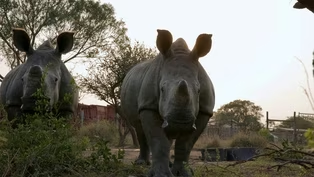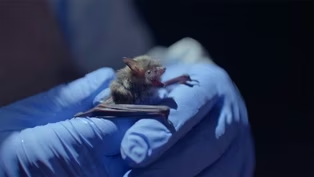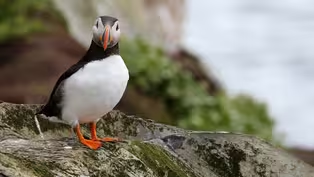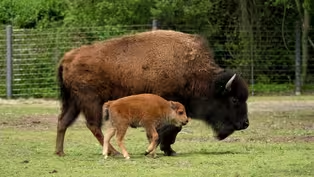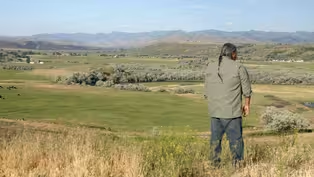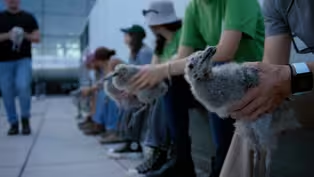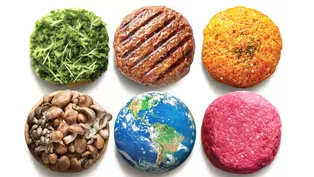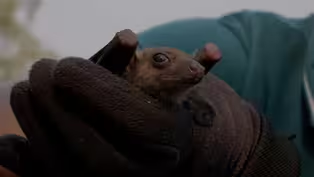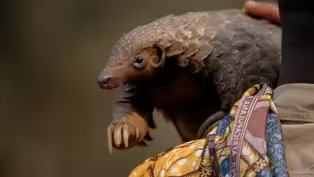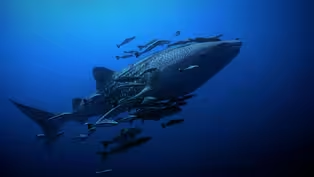
Coffee for Water | WILD HOPE
Special | 28m 1sVideo has Closed Captions
A national park grows coffee to save a rainforest.
Decades of war and unsustainable agriculture have stripped almost half the trees from the rainforest atop Mozambique’s Mount Gorongosa. The devastation threatens the watershed that sustains life in nearby communities and in Gorongosa National Park. Now, park experts and local farmers are uniting to plant a new shade-loving cash crop—coffee—that will help restore the forest.
Problems playing video? | Closed Captioning Feedback
Problems playing video? | Closed Captioning Feedback
Major support for NATURE is provided by The Arnhold Family in memory of Henry and Clarisse Arnhold, Sue and Edgar Wachenheim III, The Fairweather Foundation, Charles Rosenblum, Kathy Chiao and...

Coffee for Water | WILD HOPE
Special | 28m 1sVideo has Closed Captions
Decades of war and unsustainable agriculture have stripped almost half the trees from the rainforest atop Mozambique’s Mount Gorongosa. The devastation threatens the watershed that sustains life in nearby communities and in Gorongosa National Park. Now, park experts and local farmers are uniting to plant a new shade-loving cash crop—coffee—that will help restore the forest.
Problems playing video? | Closed Captioning Feedback
How to Watch Nature
Nature is available to stream on pbs.org and the free PBS App, available on iPhone, Apple TV, Android TV, Android smartphones, Amazon Fire TV, Amazon Fire Tablet, Roku, Samsung Smart TV, and Vizio.
Buy Now
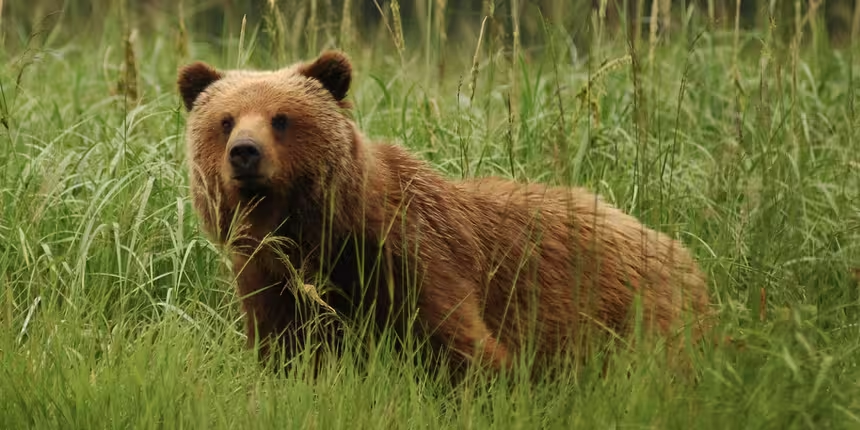
Explore More Ways to Watch
Bring the beauty and wonders of wildlife and natural history into your home with classic NATURE episodes.Providing Support for PBS.org
Learn Moreabout PBS online sponsorshipMore from This Collection
WILD HOPE is a new series of short films that highlights the intrepid changemakers who are restoring our wild places and sparking new hope for the future of our planet.
Video has Closed Captions
How does a densely populated nation like Singapore transform into a lush green oasis? (14m 51s)
Video has Closed Captions
For decades, rhinos have been the face of poaching. (16m 28s)
Video has Closed Captions
As a deadly fungus devastates North America’s bats, scientists are testing new ways to save them. (14m 47s)
Video has Closed Captions
In the Westman Islands, one community has banded together to save lost young puffins. (13m 15s)
Video has Closed Captions
Sixty million American bison once thundered across the prairies of North America. (18m 52s)
Reclaiming Bear River | WILD HOPE
Video has Closed Captions
The Bear River was once a lush area with wetlands, hot springs, and abundant wildlife. (17m 25s)
Building for Birds | WILD HOPE
Video has Closed Captions
Millions of migrating birds pass through our yards, but glass windows pose a deadly threat. (16m 3s)
Mission Impossible | WILD HOPE
Video has Closed Captions
Meet the genius behind the plant-based Impossible Burger. (39m 41s)
Pangolin Protectors | WILD HOPE
Video has Closed Captions
Due to the demand for their scales, pangolins are the most trafficked animal in the world. (12m 24s)
Way of the Elephants | WILD HOPE
Video has Closed Captions
Elephant migration corridors in India are a necessary thoroughfare for one of the largest animals. (15m 11s)
Whale Shark Homecoming | WILD HOPE
Video has Closed Captions
A renowned spiritual leader is inspiring fishermen to become guardians of the world’s biggest fish. (16m 49s)
Providing Support for PBS.org
Learn Moreabout PBS online sponsorship[distant gunfire] [distant shouting] [woman speaking] [vehicle passing] [distant gunfire] ♪ ♪ NARRATOR: Every morning Sional Sérgio Moiane begins his day with a drink that's unusual for this part of Mozambique: coffee.
♪ NARRATOR: Sional is the coffee expert on a pioneering project... [motorcycles passing] ...that's growing coffee to help both people and animals in one of the wildest places in the world: Gorongosa National Park.
♪ The park spans some 1,500 square miles in the middle of Mozambique in southern Africa.
♪ It was once home to some of the densest populations of animals on the entire continent.
[man shouting] But during a 15-year-long civil war that started in 1977, starving soldiers and poachers slaughtered nearly 95% of the park's large mammals.
[gunfire] [explosion] [Pedro speaking] NARRATOR: Since 2004, the government of Mozambique and the US-based Carr Foundation have been restoring and protecting the park's wildlife.
Today the Gorongosa Restoration Project is an amazing comeback story, with some 90,000 large animals now inhabiting the park.
That's nearly as many as before the war.
♪ But while the animals' numbers have rebounded, one of the most important parts of the park has languished.
And Sional is helping lead an urgent effort to restore this crucial habitat.
♪ It's a single mountain about 55 miles to the northwest, Mount Gorongosa.
Its top and upper slopes are covered with vibrant rain forest.
The mountain creates its own weather.
Frequent rains feed a critical water catchment, whose rivers sustain the park and communities below.
♪ [Pedro speaking] ♪ NARRATOR: During the six-month dry season, the forest's great sponge releases the stored-up rains... ...becoming the major source of water for the park's wildlife and the nearly 200,000 people living around it.
♪ But this crucial ecosystem is in jeopardy.
♪ 40% of the rain forest has been lost in just the last 50 years; another casualty of the conflict.
[Sional speaking] NARRATOR: To this day, many people survive on the mountain by clearing forest, decreasing the mountain's ability to hold water.
It's a recipe for disaster.
And that's why Sional is here.
NARRATOR: Over the years, the park has taken a community-based approach, by pioneering programs that benefit people, not just the wildlife.
Now it's applying that same strategy to reforestation.
Instead of protecting Mount Gorongosa's forest by keeping people out, it's actively recruiting them; enticing them with something that can both restore the forest and support the community: coffee beans.
[Sional speaking] NARRATOR: For nearly a decade, Sional has been training local farmers to plant coffee that grows best in the shade.
A crop that thrives under bigger, native trees.
♪ Today, it's a group planting session.
The saplings are grown on the mountain, then donated to the farmers.
♪ After the harvest, the farmers can sell the coffee back to the park.
♪ [Sional speaking] NARRATOR: Can coffee save a rain forest, provide for a community, and preserve a wildlife park?
Success requires abandoning long-standing practices and adopting new ones.
[men talking] Seriano Tacanhe Semente is one of over 800 farmers now growing coffee.
[Seriano speaking] NARRATOR: Seriano once practiced traditional slash-and-burn cultivation.
[Seriano speaking] NARRATOR: It'll be three years before the farmers can start harvesting the coffee beans, called cherries.
Until then, they'll need another source of income.
[Pedro speaking] NARRATOR: The park also supports intercropping by donating seeds of food crops like beans and pigeon peas.
They grow well alongside coffee plants and ripen at different times.
[people talking] Before and after the coffee trees mature, they'll have a variety of crops to eat and sell.
[whooping] [laughter] [laughter] [laughs] [Seriano speaking] [Sional speaking] NARRATOR: These farmers can earn twice as much from coffee as than they can from other crops, by selecting the better beans.
[Sional speaking] [Seriano speaking] NARRATOR: The park also provides the infrastructure, and additional jobs, to turn their coffee crop into cash.
[Sional speaking] NARRATOR: The result is a premium arabica coffee that's in high demand in Mozambique and abroad.
And it's changing the fortune of families and entire communities.
♪ The stakes are so high, people have risked their lives to keep the program going.
♪ After the civil war, conflict flared up periodically on the mountain, threatening those who worked here.
[Vaida speaking] [gunfire] NARRATOR: Vaida João was one of five volunteers who risked their lives time and again to water 70,000 saplings the park was cultivating for the farmers.
For months, they snuck past patrols to safeguard the nursery.
♪ The plants and program survived the conflicts.
And since 2019, a peace accord has brought a fragile calm to this area.
♪ Today, the coffee nursery Vaida protected produces three times more saplings; plants that need a reforested canopy to thrive.
♪ Bringing those trees back to the land rests on the shoulders of Marcos Bera Chova.
♪ NARRATOR: Chova is a reforestation specialist tasked with repopulating Mount Gorongosa with native trees.
NARRATOR: Chova identifies native trees best suited to shade the coffee plants, then distributes their seeds to coffee farmers to grow beside their crop.
[Chova speaking] NARRATOR: The park has cultivated more than 800,000 coffee plants so far, and is planting 20,000 native trees every year.
These efforts, along with those to stop further clear-cutting, are bringing back a lost forest to parts of the mountain, and helping to protect the water cycle.
[Chova speaking] ♪ NARRATOR: But even with these ongoing restoration efforts, two and a half acres of forest are still being lost every day.
So the park is helping farmers develop other livelihoods that benefit people, coffee, and forest.
[people talking] [laughs] Chova is teaching coffee farmer Isabel Verniz about another cash crop.
♪ [Chova speaking] [Isabel speaking] ♪ NARRATOR: Isabel sells her honeycombs to the park for processing and marketing, just like she does with her coffee.
Today, this homemade honey is a special treat for her family.
[Isabel speaking] [group singing] [Pedro speaking] [woman speaking] ♪ [Sional speaking] ♪ ♪

- Science and Nature

Explore scientific discoveries on television's most acclaimed science documentary series.

- Science and Nature

Learn how centuries of knowledge helped our ancestors understand the mysteries of space.












Support for PBS provided by:
Major support for NATURE is provided by The Arnhold Family in memory of Henry and Clarisse Arnhold, Sue and Edgar Wachenheim III, The Fairweather Foundation, Charles Rosenblum, Kathy Chiao and...

